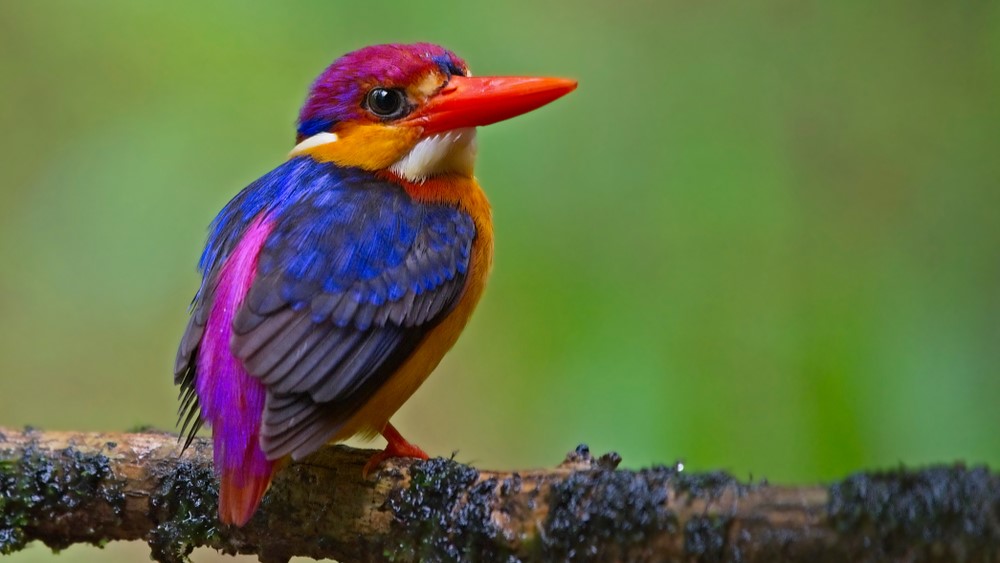
Nature produces some truly extravagant costumes, and birds have evolved more than their fair share of dazzling outfits. Often, it's the male birds that steal the show with bold colors and unfurling feathers, which they need to impress choosy females. But sometimes, both males and females are dressed to impress.
You're probably familiar with the peacock, or peafowl, and its ornamental eyespots. But there are plenty of other birds with similarly over-the-top displays, including Wilson's bird of paradise, which unfurls an iridescent-green cape around its neck to woo the ladies, and the resplendent quetzal, which plunges toward potential mates while trailing its metallic-blue feathers.
So, without further ado, here are 32 of the most colorful birds in the world.
Keel-billed toucan

The keel-billed toucan (Ramphastos sulfuratus), also known as the rainbow-billed toucan, is a tropical bird with a range extending from southern Mexico to northern Colombia and northwestern Venezuela. Its plumage is mostly black, with a yellow throat and cheeks, light-green eye patches and bright-red feathers peeking out from under its tail. But the keel-billed toucan's real showstopping characteristic is its multicolored bill, which makes up about one-third of the bird's 20-inch (51 centimeters) length.
Despite being oversize, the bill is hollow and therefore quite light, according to the American Bird Conservancy. Keel-billed toucans use it to gather food — including fruit, insects, lizards, tree frogs and eggs — which they toss into the air before gulping down. The bill's green, orange, blue and red hues also attract potential mates, and research suggests the whole appendage is laced with fine blood vessels that enable keel-billed toucans to regulate their body temperature.
Splendid fairy wren

The splendid fairy wren (Malurus splendens) lives up to its name during the breeding season, when males develop magnificent, cobalt-blue feathers and a sky-blue crown and cheeks to impress females. These birds, which grow to 5 inches (13 cm) long, live in dense shrublands or woodlands of acacia in parts of Australia. Like most fairy wrens, splendid fairy wrens feed mostly on insects, which they pick off the ground and out of shrubs.
In September, males swap their pale-brown and buff plumage for bold, electric-blue shades and a black eye mask. They then begin their courtship display, which involves plucking pink and purple petals for potential mates. Meanwhile, females build domed nests of dry grass, scraps of bark and rootlets that are so small that the birds have to bend their tails during incubation.
Gouldian finch

Also known as the rainbow finch, the Gouldian finch (Chloebia gouldiae) is a species of grassfinch that comes in three color combinations, with a black, red or yellow face to complement its bright-green back, turquoise neck, yellow belly and purple breast. Black is the most common facial color, found in 75% of Gouldian finches, with red-faced birds making up most of the remaining 25% and yellow-faced birds occurring rarely.
Gouldian finches inhabit the edges of mangrove forests, thickets and savannas in northern Australia, where they feed on grass seeds and insects. These highly sociable birds usually gather around water in flocks numbering several hundreds of birds, as they need to drink several times a day.
The Gouldian finch's bright colors have made it a target for illegal trapping. Together with habitat loss, predation, parasites and wildfires, the illegal bird trade has reduced the wild population to fewer than 2,500 birds.
Fiery-throated hummingbird

The fiery-throated hummingbird (Panterpe insignis) is a species of hummingbird found in the forested highlands of Costa Rica and western Panama. Its 4-inch-long (10 cm) body is covered in iridescent feathers, which fade from dark orange at the base of the throat to yellow and bluish green on the belly and back, and to a shimmering royal blue on the breast and crown. Although males are slightly larger than females, both sexes look alike and sport a long, slender, black bill with a pink base that they use to feed on the nectar of small flowers, shrubs and trees.
Indian peafowl

Male Indian peafowl (Pavo cristatus), more commonly known as peacocks, are famous for their iridescent-blue feathers and eyespot-covered tails that they spread out to woo females. Females are less flamboyant than males, with mottled-brown plumage and a shorter tail lacking eyespots, although they sport iridescent-green feathers on their throats.
Indian peafowl are native to the Indian subcontinent, but they have been introduced to many other parts of the world — including North America, Europe, South Africa and Australia — as ornamental birds. In the wild, Indian peafowl live on the forest floor, where they forage for fruit, small reptiles, insects and rodents.
Lilac-breasted roller

The lilac-breasted roller (Coracias caudatus) gets its name from its acrobatic courtship display, which involves males repeatedly rising and plunging down with their wings tucked in to perform rolls while simultaneously shouting raucous calls. Lilac-breasted rollers grow 14.5 inches (37 cm) tall, with both males and females sporting a lilac throat and breast, a turquoise belly, a green head, a reddish-orange face and royal-blue tail tips.
The species lives in grasslands and wooded areas across eastern and southern Africa, from Ethiopia and Angola to northern South Africa. The birds sit on dead trees to survey their surroundings for prey, including grasshoppers, beetles, lizards, frogs and crabs. They are known to pick off animals that are fleeing from bush fires and to invade the nests of other birds, including kingfishers and woodpeckers.
Wilson's bird of paradise

Wilson's bird of paradise (Diphyllodes respublica) is named after British ornithologist Edward Wilson, who donated a specimen discovered in 1850 in Indonesia to the Academy of Natural Sciences in Philadelphia. The male bird is the size of a sparrow and boasts bright-red plumage on its back, a yellow patch on the top of its neck and a featherless crown, revealing electric-blue skin beneath. Wilson's bird of paradise also has two distinctive, sickle-shaped tail feathers.
The bird is so elusive that it took scientists 150 years to document its courtship display, during which the male unfurls his neck feathers to reveal an iridescent-green cape. Females judge potential mates by the brightness of their feathers, but they themselves have olive-brown, mottled plumage. Like the males, females have a bald patch on the top of the head and blue skin.
Red-necked tanager

The red-necked tanager (Tangara cyanocephala) is a tropical bird found in lowland forests in eastern Brazil, Argentina and Paraguay. Its plumage is mostly light green, with a distinctive scarlet nape and cheeks, a light-purple crown and a blue throat. Red-necked tanagers feed at the top of fruiting trees, but they occasionally drop to the forest floor to pluck berries off shrubs. They live up to five years.
Resplendent quetzal

The resplendent quetzal (Pharomachrus mocinno) is a stunning, turquoise, green and red bird that lives in the cloud forests stretching from southern Mexico to western Panama. Males sport a golden-green crest and metallic-blue tail feathers that grow during the breeding season to form a flowing train up to 3 feet (0.9 meter) long. They show off this train by rising above the canopy and plunging down toward potential mates, with their feathers rippling behind them.
The resplendent quetzal was considered sacred by Mesoamerican civilizations and remains an important symbol today, with the bird featured on Guatemala's flag. According to legend, the resplendent quetzal was the spirit guide of a Maya prince and hero called Tecún Umán, who died fighting the Spanish conquest. As Tecún Umán lay wounded, a resplendent quetzal landed on his chest and stained its feathers with blood, accounting for the bird's red breast and belly.
Spangled cotinga

The spangled cotinga (Cotinga cayana) is a tropical bird that lives in the forests and jungles of northern South America, including in the Amazon rainforest in Brazil. Males have striking light-blue feathers on their breast and belly, bluish-black wings and a magenta throat. These attributes help them attract females, which have a much duller brown plumage. Spangled cotingas, which grow to between 7 and 9 inches (18 to 23 cm) long, are often seen perching on fruiting trees, although their diet also includes protein-rich insects during the breeding season.
Mandarin duck
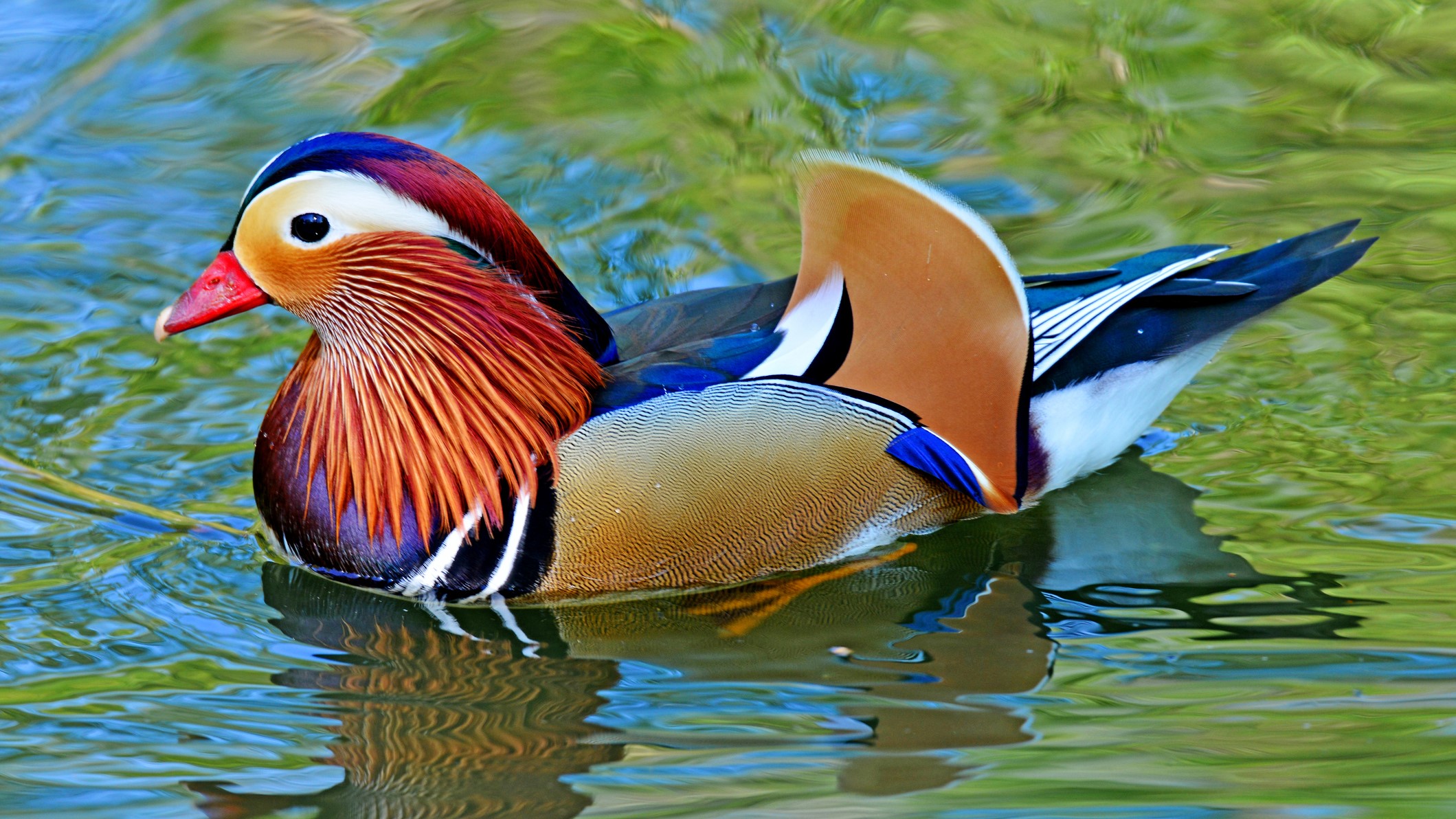
As with many other birds, it's the male mandarin duck (Aix galericulata) with standout colors. Male mandarin ducks have distinctive orange cheeks and "sails" on their backs, as well as a purple chest and royal-blue and green feathers in their crown and tail. Females have creamy-white and mottled-brown plumage and a gray head and cheek feathers that fluff up like the males'. Adults of both sexes reach between 8 and 10 inches (20 to 25 cm) long, with females growing slightly plumper than males.
Mandarin ducks are native to the Far East, including China, Japan, Korea and parts of Russia. The species was introduced to the U.K. in the 20th century, and populations also exist in parts of the United States., where the ducks are thought to have escaped from captivity.
Crimson rosella

Despite its name, the crimson rosella (Platycercus elegans) comes in several shades, including red, orange and yellow. Juveniles have olive-green feathers that transition to one of the other colors when the birds mature. Regardless of their makeup, crimson rosellas have distinctive blue patches on their cheeks, blue tail feathers and wings with black dots.
Crimson rosellas are found mostly in southern and eastern Australia, with a few populations scattered across the rest of the country, as well as on Norfolk Island and in New Zealand. They normally hang out in small flocks and feed on seeds, grasses, shrubs, insects and some tree blossoms. The birds produce a range of calls, including some that sound like harsh screeches and metallic whistles.
Common kingfisher
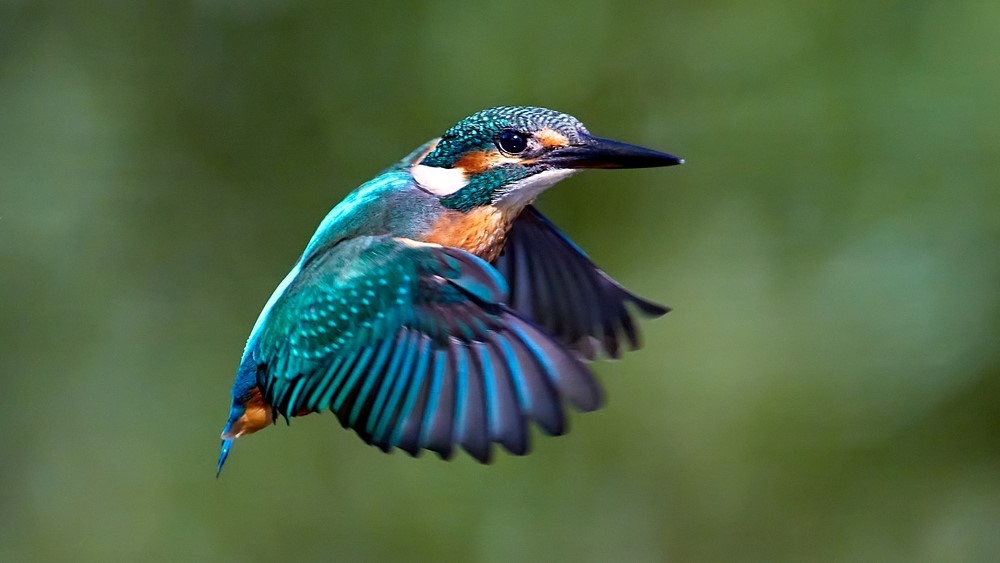
The common kingfisher (Alcedo atthis) is a bright-blue-and-orange-feathered bird that's widely distributed across Europe, Asia and North Africa. It's a rather shy and inconspicuous bird with a long, pointed bill, which it uses to pluck small fish out of slow-moving and still water. These birds often perch in trees along rivers and streams, diving low above the water when they spot a potential meal.
The common kingfisher grows to around 6 inches (15 cm) long and has a wingspan of 10 inches (25 cm), which is slightly larger than a European robin's (Erithacus rubecula). Its back is metallic blue, and its breast is coppery-brown. Females can be distinguished from males by a red patch at the base of the bill.
Red-bearded bee-eater

The red-bearded bee-eater (Nyctyornis amictus) is a striking, leaf-green bird that lives in the lowland and foothill forests of southern Myanmar, Thailand, Malaysia, Borneo and Sumatra. It is named after the scarlet feathers that stretch from the base of its bill to its belly. The red-bearded bee-eater also has a pink crown, orange eyes and yellow feathers on the underside of its tail. Its unique song is characterized by a series of frog-like croaks.
Like other bee-eaters — a group of colorful birds comprising 27 species — red-bearded bee-eaters have elongated central tail feathers, a downward-curved bill and pointed wings. They predominantly eat insects; as their name suggests, and they have a soft spot for bees, which they stun before eating by banging the insects' heads on a branch.
Paradise tanager

The paradise tanager (Tangara chilensis) is a 5.5-inch-long (14 cm) songbird with a lime-green head and a turquoise breast and belly. Depending on the subspecies, of which there are four scientists know, paradise tanagers have red or yellow feathers at the base of their tails. They are native to the Amazon rainforest and northern South America. Paradise tanagers like to stay high in the canopy, hanging out in mixed-species flocks and moving rapidly between perches as they forage.
Scarlet macaw

As its name suggests, the scarlet macaw (Ara macao) is mostly covered in bright-red feathers. But this bird also has a blue lower back and wing tips, as well as a yellow rump and a white, featherless face. Scarlet macaws are the largest parrots in the world, measuring up to 33 inches (84 cm) from beak to tail end. Their beaks are strong enough to crack hard nuts found in the rainforests spanning from southern Mexico to Peru and eastern Brazil where these birds live. Scarlet macaws mate for life and spend most of their time in large, noisy flocks.
Wood duck

Wood ducks (Aix sponsa), also known as Carolina ducks, are native to North America; they live year-round in the southeastern United States and along the Pacific coast. Many wood ducks living along the Gulf and Atlantic coasts migrate north to cooler climates during the summer. Males have striking red eyes and a red bill that fades into yellow at the base. Their crown and crest are an emerald green, with white stripes that extend to form a collar around the neck. Males also have a dark-red breast, golden-yellow sides and blue feathers on their tail and wings. Females have mottled, grayish-brown plumage and a white ring around each eye. Wood ducks grow to around 19 inches (48 cm) in length and have a wingspan of 28 to 39 inches (71 to 99 cm).
Painted bunting

The painted bunting (Passerina ciris) is a rainbow-colored bird that's native to North America, with an eastern population that breeds in Georgia and South Carolina and a western population centered in Texas. The eastern birds migrate to Florida and the Caribbean for the winter, while the western flock heads to the Pacific shores of Mexico. The birds in these populations look and sound similar, with adult males sporting electric-blue feathers on their crown, a red breast and a lime-green upper back. Females and young males are plain green with no markings. The painted bunting's song is loud and shrill, and its call is sharp and metallic.
Violet sabrewing

The violet sabrewing (Campylopterus hemileucurus), which grows up to 6 inches (15 cm) long, is the largest species of hummingbird in Mexico and Central America. Males are covered in iridescent, bluish-purple feathers that glimmer in sunlight and look blackish in the shade. Females are less resplendent, with just a few shimmering feathers around their neck and cheeks. Both males and females have a thick, arched bill and white tail corners. The violet sabrewing is found in humid evergreen forests, where it feeds on the nectar of understory flowers, including banana flowers, and shrubs.
Rainbow lorikeet

The rainbow lorikeet (Trichoglossus moluccanus) is a highly colorful bird found in northern and eastern Australia. It has a red bill, a blue head and belly, a green back and wings and a dappled yellow-and-orange breast. Males and females look alike and grow to around 12 inches (30 cm) from beak to tail.
The rainbow lorikeet is classified as a "true" parrot because it is herbivorous and has a hooked bill. There are about 350 known species of true parrots (Psittacoidea), which include macaws, lorikeets and budgerigars.
Black-backed dwarf kingfisher

The black-backed dwarf kingfisher (Ceyx erithaca) is one of the smallest known kingfishers, growing to between 5 and 5.5 inches (13 to 14 cm) in length (including the bill and tail). Its crown and tail are fuchsia red, and its bill is coral red and shaped like a dagger. The bird also has a pale-orange belly and cheeks; patchy, dark-blue wings; and a white throat. Black-backed dwarf kingfishers are often found away from water sources, with a range extending across Southeast Asia, from Malaysia and Vietnam to Taiwan, Bhutan, western India and Sri Lanka.
Vulturine guineafowl

The vulturine guineafowl (Acryllium vulturinum) is a goose-size, long-necked bird that's native to eastern Africa, with a range extending from southern Ethiopia to northern Tanzania. Vulturine guineafowl live in flocks of up to a dozen birds and roam around dry savanna and scrublands, foraging for seeds, tubers, roots, small reptiles, rodents and insects. They have an electric-blue breast and back overlaid with long, black-and-white feathers, as well as red eyes, a bald head, and a chestnut patch on the nape. The rest of their plumage is black speckled with white. Young vulturine guineafowl are dull brown.
Curl-crested aracari

The curl-crested aracari (Pteroglossus beauharnaesii) is a small toucan found in humid tropical forests across Bolivia, Brazil and Peru. The species is named after its crown, which is covered in soft, grayish curls. The curl-crested aracaris has a turquoise circle around its eyes, scarlet feathers on its nape and belly, speckled cheeks and an enormous, colorful bill. It is not as vocal as other aracaris, a group of birds that includes medium-size toucans and the saffron toucanet (Pteroglossus bailloni). Instead, it produces only soft grunts and an occasional loud yelp. Curl-crested aracaris fly around the forest canopy in flocks of up to a dozen birds, foraging for fruit, as well as other birds' eggs and chicks.
Golden pheasant

The golden pheasant (Chrysolophus pictus), also known as the rainbow pheasant, is native to China and was introduced to the U.K. in the 1700s and to Hawaii in the mid-1990s. Males, which grow up to 3.8 feet (1.16 meters) long from head to tail tip, have bright-red feathers on their breast and underparts, a golden quiff and lower back, and a striped, orange-and-black neck. Like other pheasants (Phasianidae), it also has a long, finely striped tail. Females are pale brown and finely striped all over. Golden pheasants are shy and surprisingly difficult to spot, as they keep to dark, dense woodland and roost in the trees at night.
Scarlet-chested parrot

The scarlet-chested parrot (Neophema splendida) is a nomadic bird found mostly in the Great Victoria Desert of southwestern Australia. It can survive for long periods without access to drinking water by sucking moisture out of succulent plants. Males have a bright-blue head and wings, scarlet feathers on their breast, a green back and yellow underparts. Females are slightly duller in color and lack a scarlet chest. Scarlet-chested parrots grow to around 7.8 inches (20 cm) in length and cry out soft, two-syllable calls that sound like chirps when repeated. They also emit sharp whistles when they feel threatened.
Roseate spoonbill

The roseate spoonbill (Platalea ajaja) is a large wading bird named after its two most striking features: pink plumage and a long, flattened, spoon-shaped bill. Although its neck and upper back are white, its breast, middle back and wings are baby pink. The lower back, front of the wings and tail are scarlet, with an orange patch above the wings and around the eyes. Juveniles are dusty pink,and their heads are covered in feathers, which fall out as the birds mature to reveal pale-green scalps.
Roseate spoonbills are found in freshwater and saltwater marshes from the Gulf Coast of the United States through much of South America, living as far south as the Falkland Islands in the South Atlantic Ocean. They grow up to 2.5 feet (76 cm) tall, and the largest roseate spoonbills attain a wingspan of 4 feet (1.2 m).
Nicobar pigeon

The Nicobar pigeon (Caloenas nicobarica) is a ground-dwelling bird found on small islands and coastal regions from India's Andaman and Nicobar islands to the Solomon Islands in the South Pacific Ocean. It is the only extant member of its genus and possibly the closest living relative of the extinct dodo, according to Avibase. The Nicobar pigeon has a mane of blue feathers that hangs from its neck like a hula skirt, as well as green, yellow and copper feathers on its back. It is slightly larger than other pigeons, measuring around 1.3 feet (40 cm) long. Nicobar pigeon numbers are declining in the wild due to being captured for the pet trade and being hunted for food and their gizzard stones, which are used to make jewelry. Habitat loss and invasive species also threaten these birds.
European bee-eater

The European bee-eater (Merops apiaster) is one of 27 known bee-eater species, which include the aforementioned red-bearded bee-eater. European bee-eaters are more widely distributed than their name suggests, with a range spanning through eastern and southern Africa, Europe and Mongolia. The European bee-eater's long, pointed bill helps it catch insects in midair before it bashes them against a branch to stun the insects and remove any venom-loaded stings. The European bee-eater is brightly colored, with a canary-yellow throat, a blue belly and tail tips, and a copper crown that fades into mustard-yellow feathers on its back. These gregarious birds nest colonially in burrows, which they dig out of vertical sandbanks.
Crimson sunbird
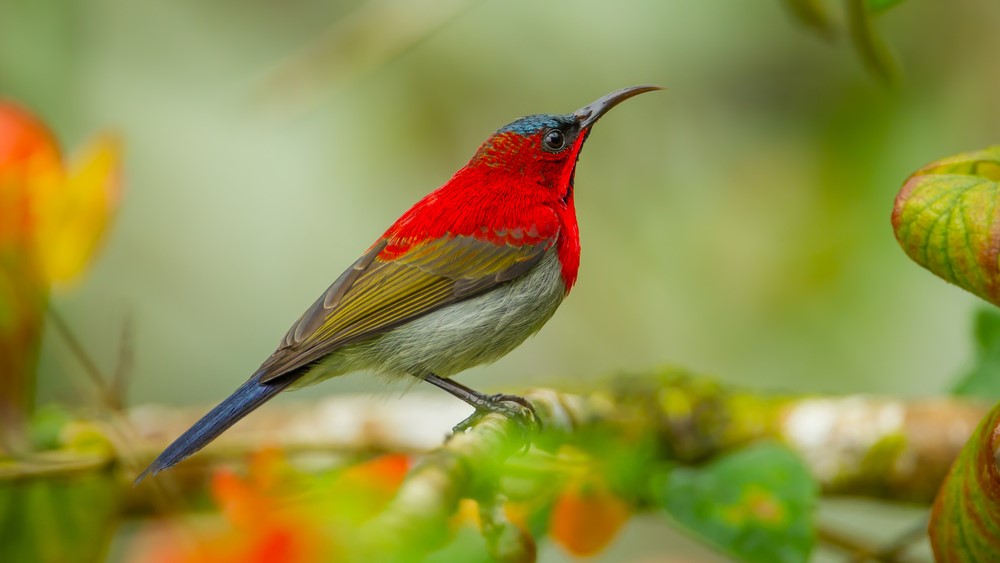
As its name suggests, the crimson sunbird (Aethopyga siparaja) has striking red feathers, which form a poncho around its breast and back. Males also have an iridescent-blue cap and dark, mustache-like markings on their neck. Females are olive yellow and lack these decorative features. Crimson sunbirds, which grow up to 5.3 inches (13.5 cm) long, are common throughout Southeast Asia, with a range extending from northern India to Malaysia and Indonesia. They can hover in the air like hummingbirds and similarly feed on the nectar of flowers, but they also often perch while foraging.
Violet-backed starling

The violet-backed starling (Cinnyricinclus leucogaster), also known as the plum-colored starling or amethyst starling, is a highly sexually dimorphic species — meaning male and female birds look drastically different. Male violet-backed starlings have a top half covered with iridescent-purple feathers that change shade depending on the light. Their breast and underparts are snowy white. Females also have white underparts, but their back and head are brown and their entire body is streaked with dark brown. Violet-backed starlings, which grow to around 6.7 inches (17 cm) long, live in forests across eastern, southern and western Africa. They feed on fruit and insects, and they play an important role in dispersing mistletoe seeds throughout their habitat.
Golden-hooded tanager

Unlike violet-backed starlings, male and female golden-hooded tanagers (Tangara larvata) look alike, with light-blue feathers standing out against mostly black plumage and a dark-yellow hood framing the face. The violet-backed starling also has an orange patch on its throat, as well as white underparts. These birds have a range extending from southern Mexico to northwestern Ecuador, and are sometimes seen in feeding flocks with other birds, such as honeycreepers (Cyanerpes) and euphonias (Euphonia). Golden-hooded tanagers, which grow to about 5 inches (13 cm) long, build their nests in between forked tree branches or in bunches of green bananas.
Indian roller
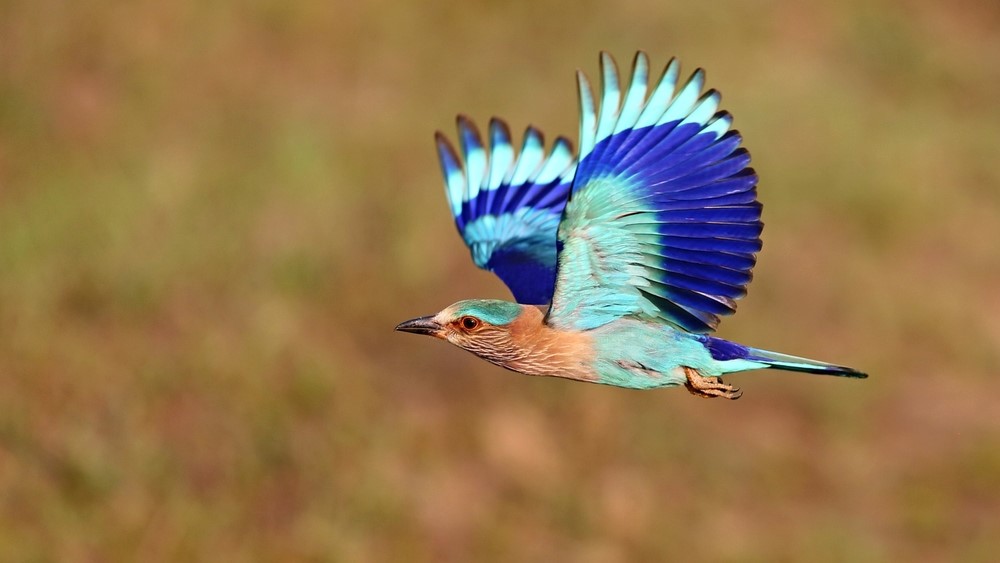
The Indian roller (Coracias benghalensis) shows off its colors best when it's flying, revealing light-blue wings with sapphire bands and tips. The same color combination is present on its tail feathers, which fan out into a large V shape. Males and females look alike, with a dark-olive back, a salmon-colored breast, and narrow, protruding feathers around the bill. Both sexes measure up to 13 inches (33 cm) in length, with a wingspan reaching 29 inches (74 cm). Indian rollers inhabit open, agricultural areas in India, around the Persian Gulf and along the coast of Oman. They like sitting on exposed perches, including electric wires.







